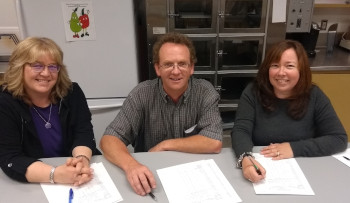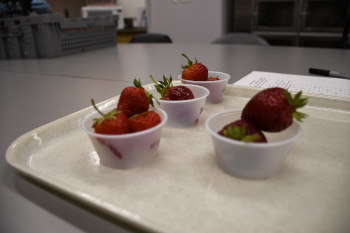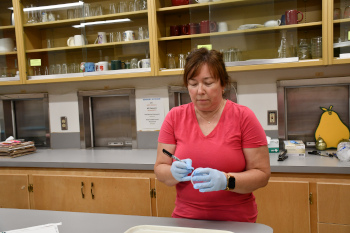For more information
Media Relations
Agriculture and Agri-Food Canada
1-866-345-7972
aafc.mediarelations-relationsmedias.aac@agr.gc.ca
Every day, from the moment we wake up to the time we rest, our brain makes thousands of choices. Research says our brains are making approximately 35,000 decisions daily. What will we eat for breakfast? What will we wear today? How will we get to work? To make these decisions, our brains rely on our senses to help guide us. From perceiving sights, sounds, smells, touch and tastes; our senses are very important to shaping our daily experiences.
Scientists at Agriculture and Agri-Food Canada (AAFC) rely on the senses of volunteers to help them breed the perfect fruits. Karen Burgher-MacLellan, a recently retired research biologist at the Kentville Research and Development Centre (RDC) in Nova Scotia, ran the fruit sensory evaluation program which conducts assessments on fruits including strawberries, blueberries, raspberries, blackberries, apples, and pears. Fruit sensory evaluation is the process of trained panelists assessing fruits based on the visual appearance, taste, texture, and aroma before they are released by AAFC fruit breeding programs.

Strawberry samples grown at the Kentville RDC are evaluated by panelist to help ensure the new varieties are meeting consumers expectation.
Dr. Beatrice Amyotte, who leads the small fruit breeding program at the Kentville RDC, collaborated closely with Karen. The outcomes from Karen’s research trials from 2020 to 2023 support Dr. Amyotte’s ongoing development of new small fruit varieties and will help ensure the new varieties meet consumers expectation. Although retired, Karen’s research will continue to shape the future of fruit breeding. Work has already begun, and the new breeding selections will undergo trials during the 2024 season based on the results of her work.
Outcomes helping to advance small fruit breeding
Before retirement Karen completed a three-year trial that collected sensory data on strawberries, raspberries, blackberries, apples, and pears developed at the Kentville RDC. Panelists were asked to rate each fruit sample in several ways, for example by identifying if a strawberry was “not quite sweet enough”, “just about right” or “far too sweet”. Another way panelists rated the samples was to select which categories best described the fruit, for example if an apple was “crunchy”, with “citrus” aroma, or “soft” with “tropical” aroma. Karen and her team analyzed the data to detect significant variations in fruit quality ratings like appearance, flavor, texture, sweetness, sourness and bitterness. They then assessed how these descriptors changed for each fruit variety tasted by the panelists in a single week, over multiple weeks in one season, and over the 3 years of the study.
Karen discovered that panelists excelled in pinpointing characteristics that affect the quality of the fruit samples. For instance, the trial results revealed that panelists consistently rated fruit texture as highly important to their enjoyment of the fruit. If the fruit was found to be crisp, firm or juicy, it correlated with a preference for those textures. She also found that, on average, the panelists preferred strawberries to raspberries and blackberries.
The efficiency of home-based evaluation methods
Prior to the pandemic, Karen conducted on-site fruit sensory evaluations for several years. During this process, each panelist came into the sensory lab at the Kentville RDC for training. Once they were comfortable with the evaluation process, they were provided a variety of fruit samples and a paper ballot. The paper ballot had various questions related to how often they ate the fruit being evaluated. Using different scales, the panelist rated the fruit for taste, appearance, texture, size, colour, and aroma. This process usually took 60 to 80 minutes to evaluate 6 to 8 samples. The data from these evaluations was analyzed by an onsite statistician. The standard process was lengthy, but the goal was to ensure that the new fruits to be released would meet consumers’ expectations and commercial criteria.
When the pandemic happened in 2020, sensory panels could no longer take place in-person, and Karen and her team needed to quickly adapt, implementing a new evaluation method. Karen was introduced to the Canadian company Compusense. They provide a specialized program, including an online secure web portal, allowing sensory evaluation testing to be conducted securely from the participants’ homes.
The panelists picked up their samples from the Kentville RDC, and when they were ready to begin, they were instructed to find a quiet area and login into the secure website with a username and password. The ballot began, and panelists would answer 5 question types on the ballot. For example, “How often do you eat strawberries?” or “Where do you prefer to buy strawberries?”. Panelists chose their preferences for appearance, flavor, texture, and taste. With this easy-to-use survey, the panelists needed less training, and the evaluation was completed at their convenience. The program made it easier for the sensory team to collect and interpret the data, as the process was digitalized.
"With Karen’s method, we can evaluate both existing market varieties and new ones we are breeding. By utilizing this method, we can determine if our new varieties match or surpass the commercial ones. Ideally, we aim for the new selections to outperform the standard varieties. However, other factors like adaptability to climate change, storage capacity, consistency, and quality across various growing seasons are also essential considerations."
- Dr. Beatrice Amyotte, research scientist, Agriculture and Agri-Food Canada
Read more about how Karen and her team adapted the sensory program in 2020: Comparing apples to apples: Karen Burgher’s fruit sensory evaluation program adapts to a virtual world
As the pandemic restrictions eased, the sensory team continued with at-home sensory evaluations since the new method proved to be more efficient and convenient. Karen and her team are confident the at-home sensory evaluation is the best choice for future sensory analysis after evaluating it for 3 years.
"By leveraging this tool in recent years, it’s clear that blending the traditional model with a modern twist is not only effective but also globally applicable. Panelists can take the samples home and complete their ratings on a computer or smartphone. This approach streamlines processes, saves time, cuts cost and delivers consistent outcomes."
- Dr. Karen Burgher-MacLellan, research biologist, Agriculture and Agri-Food Canada
Photo gallery


